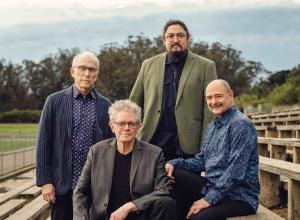The Morgan Announces Complete Digitization of Its Renowned Rembrandt Collection
New York, NY, May 21, 2014—The Morgan Library & Museum announced today that its large collection of etchings by Rembrandt Harmensz. van Rijn (1606-1669)—considered the finest in North America—has been fully digitized and will now be available online beginning May 22.
The completion of the project is a significant development for scholars, students, and members of the general public interested in the work of one of the greatest of all artists. Until now, the Morgan Rembrandt collection has been available on a select basis onsite at the museum’s New York headquarters, and some of the works have been published in various museum catalogs. The digitization effort allows access to the collection from anywhere in the world and includes a zoom feature to study individual works in detail. Rembrandt used the process of etching to test concepts and themes, and the digitized works offer the opportunity to explore up-close his use of line, shading, and subject matter. The almost five hundred images can be viewed on the Morgan’s website (www.themorgan.org).

The Rembrandt project is part of a larger, strategic initiative by the Morgan to expand access to its holdings. In recent years, more than five hundred music manuscripts from its extraordinary collection—represented by such masters as Mozart, Beethoven, Bach, and Handel—have been digitized and made available on its website. The museum’s most ambitious undertaking—the digitization of its collection of almost twelve thousand drawings—began last fall and will reach its first benchmark of two thousand available works in late June.
Pierpont Morgan, the museum’s founder, laid the foundation for the Rembrandt collection when he acquired his first etchings from Theodore Irwin, Sr., in 1900 and George W. Vanderbilt in 1906. The Morgan holds most of the three hundred or so known etchings by Rembrandt, including rare, multiple versions.
The works are notable for their dramatic intensity, penetrating psychology, and touching humanity. They also explore many of the artist’s recurring motifs and subjects including portraiture, the Bible, scenes from everyday life, the nude, and landscape. Rembrandt’s own visage is often the focus as he used self-portraiture to experiment with lighting, technique, and, above all, expression. Sensitive renderings of the artist's family—his elderly mother and first wife, Saskia—are also part of the collection. The Biblical depictions are the largest and arguably most important category. Key highlights, such as Jacob Caressing Benjamin, Abraham Entertaining the Angels, and Abraham's Sacrifice, demonstrate the unique perspective the artist brought to these Old Testament accounts. The collection includes the Morgan's pristine impression of one of Rembrandt's most ambitious compositions, Christ Preaching, popularly known as "The Hundred Guilder Print."
Another of Rembrandt’s preoccupations was the depiction of those on the fringes of Dutch society. Examples of this genre in the digitized collection include Beggar Man and Woman Behind a Bank and Beggars Receiving Alms at the Door of a House. Among the images of individuals participating in everyday activities are The Skater and one of a more earthy nature, The Monk in the Cornfield. In his later years, Rembrandt continued to produce striking imagery, such as the Self-Portrait, Etching at a Window, of which the Morgan possesses the rare first and second states. Prints of friends and contemporaries include Jan Six, the Dutch patrician and collector, who is depicted reclining gracefully against a windowsill, reading by sunlight. Rembrandt captured the spirit of the Dutch countryside—often inserting charming hidden details now much more easily seen in digital form—in works such as The Three Trees, Cottages and Farm Buildings with a Man Sketching, and Landscape with Trees, Farm Buildings, and a Tower.
“Completion of our Rembrandt project is another important milestone in the Morgan’s ongoing commitment to make its collections available to an ever wider audience,” said William M. Griswold, Director of the museum. “Few artists hold as much fascination in our collective imagination and these works offer a highly personal look into Rembrandt’s creative process. We are extraordinarily pleased to be able to share them with scholars, students, and anyone interested in his art.”
The Morgan Library & Museum
The Morgan Library & Museum began as the private library of financier Pierpont Morgan, one of the preeminent collectors and cultural benefactors in the United States. Today, more than a century after its founding in 1906, the Morgan serves as a museum, independent research library, musical venue, architectural landmark, and historic site. In October 2010, the Morgan completed the first-ever restoration of its original McKim building, Pierpont Morgan’s private library, and the core of the institution. In tandem with the 2006 expansion project by architect Renzo Piano, the Morgan now provides visitors unprecedented access to its world-renowned collections of drawings, literary and historical manuscripts, musical scores, medieval and Renaissance manuscripts, printed books, and ancient Near Eastern seals and tablets.















